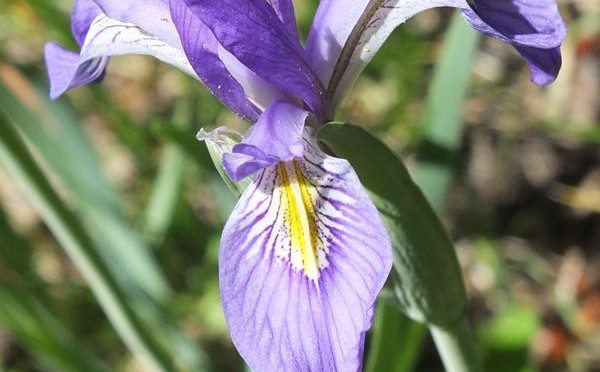
This is yet another in a series of hikes I’ve been doing in the Valles Caldera National Preserve in northern New Mexico.. Please read my article about hiking in the Valles Caldera (it includes links to articles about various trails and routes). The Alamo Canyon trailhead is reached after about an hour long trip on the back country van operated in the Preserve Friday-Monday throughout the summer.
 Alamo Canyon is a gorgeous, forested canyon with a stream and chain of ponds along the pathway for most of the hike. The trail begins at 9450 feet altitude (2881 m) at the top of the canyon and descends gently through the forest. The hike can be done as a one-way 4.7 mile (7.5 km) hike between two of the established drop-off/pick-up points for the Preserve’s back country shuttle.
Alamo Canyon is a gorgeous, forested canyon with a stream and chain of ponds along the pathway for most of the hike. The trail begins at 9450 feet altitude (2881 m) at the top of the canyon and descends gently through the forest. The hike can be done as a one-way 4.7 mile (7.5 km) hike between two of the established drop-off/pick-up points for the Preserve’s back country shuttle.
An interesting feature along the route are some broad meadows flanked by large, old aspen trees. The meadows were used as camp sites by shepherds in the early part of the twentieth century when they summered in the area with their herds. A pastime of these people involved making carvings onto the inviting white palates of aspen trees. These tree carvings are called “dendroglyphs” or “arborglyphs” and they are found in various places throughout this part of the country. I found several along this route and have included pictures later in the article. From the book “Aspen Art in the New Mexico Highlands” by James B. Dekorne: “The sheep industry in New Mexico dates back to 1598. This collection of photographs begins with the carving of one of the oldest and most universal symbols used by man – the human hand. From hand prints we go to portraits of the herders themselves. The horse is far and away the most common subject carved on aspen trees. Dogs too are a common subject. The mystique of the West is a common theme.”
 It was a fun scavenger hunt trying to spot these. Because of the growth of the trees over the years and the propensity for elk to chew off the bark of aspen trees, many of the carvings are now a bit hard to spot and interpret. I found several trees where I thought I might be looking at a carving, but I had to admit that I may have been imagining things. You be the judge. I know I don’t pass by a big aspen tree anymore without a hard study of its bark.
It was a fun scavenger hunt trying to spot these. Because of the growth of the trees over the years and the propensity for elk to chew off the bark of aspen trees, many of the carvings are now a bit hard to spot and interpret. I found several trees where I thought I might be looking at a carving, but I had to admit that I may have been imagining things. You be the judge. I know I don’t pass by a big aspen tree anymore without a hard study of its bark.
As has been the case on every hike I’ve taken in the Valles Caldera, I encountered multiple elk along the route but was never fast enough with the camera to catch an image of any. Some photos in one of the several prairie dog colonies along the way had to suffice for my wild animal photos on this day.
The canyon ends after about three miles where the creek flows into Sulfur Creek, a stream that flows by from the North. At this point, the route turns upstream and follows Sulfur Creek to a van pick-up point.






















Leave a Reply